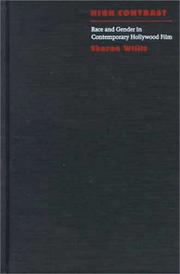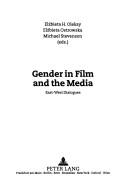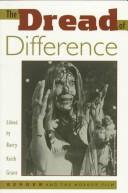| Listing 1 - 10 of 121 | << page >> |
Sort by
|
Book
ISBN: 1839829400 Year: 2021 Publisher: London, England : Emerald Publishing,
Abstract | Keywords | Export | Availability | Bookmark
 Loading...
Loading...Choose an application
- Reference Manager
- EndNote
- RefWorks (Direct export to RefWorks)
Gender and Parenting in the Worlds of Alien and Blade Runneris a comparative, gendered analysis study of Ridley Scott's contributions to the genre of science fiction and horror cinema, showcasing how patriarchal and gendered expectations regarding women, usually associated with the past, still run rampant.

ISBN: 082232041X Year: 1997 Publisher: Durham Duke University Press
Abstract | Keywords | Export | Availability | Bookmark
 Loading...
Loading...Choose an application
- Reference Manager
- EndNote
- RefWorks (Direct export to RefWorks)

ISBN: 0231076053 Year: 1998 Publisher: New York (N.Y.) Columbia University Press
Abstract | Keywords | Export | Availability | Bookmark
 Loading...
Loading...Choose an application
- Reference Manager
- EndNote
- RefWorks (Direct export to RefWorks)
Motion pictures --- Sex role in motion pictures. --- Political aspects.
Book
ISBN: 9781441109385 Year: 2013 Publisher: New York Bloomsbury
Abstract | Keywords | Export | Availability | Bookmark
 Loading...
Loading...Choose an application
- Reference Manager
- EndNote
- RefWorks (Direct export to RefWorks)
Book
ISBN: 150133445X 1501334441 1501334433 9781501334450 9781501334443 9781501334436 Year: 2017 Publisher: [London] : Bloomsbury Academic,
Abstract | Keywords | Export | Availability | Bookmark
 Loading...
Loading...Choose an application
- Reference Manager
- EndNote
- RefWorks (Direct export to RefWorks)
"Indian cinema is the only body of world cinema that depicts courtesans as important characters. In early films courtesan characters transmitted Indian classical dance, music and aesthetics to large audiences. They represent the nation's past, tracing their heritage to the fourth-century Kamasutra and to nineteenth-century courtly cultures, but they are also the first group of modern women in Hindi films. They are working professionals living on their own or in matrilineal families. Like male protagonists, they travel widely and develop networks of friends and chosen kin. They have relations with men outside marriage and become single mothers. Courtesan films are heroine-oriented and almost every major female actor has played this role. Challenging received wisdom, Vanita demonstrates that a larger number of courtesans in Bombay cinema are Hindu and indeterminate than are Muslim, and that films depict their culture as hybrid Hindu-Muslim, not Islamicate. Courtesans speak in the ambiguous voice of the modern nation, inviting spectators to seize pleasure here and now but also to search for the meaning of life. Vanita's groundbreaking study of courtesans and courtesan imagery in 235 films brings fresh evidence to show that the courtesan figure shapes the modern Indian erotic, political and religious imagination."--Bloomsbury Publishing.
Motion pictures --- Actresses --- Courtesans --- Sex role in motion pictures.

ISBN: 0820447528 Year: 2000 Publisher: Frankfurt am Main : Peter Lang,
Abstract | Keywords | Export | Availability | Bookmark
 Loading...
Loading...Choose an application
- Reference Manager
- EndNote
- RefWorks (Direct export to RefWorks)
Book
ISBN: 0815652410 9780815652410 0815633327 9780815633327 Year: 2014 Publisher: Syracuse, New York : Syracuse University Press,
Abstract | Keywords | Export | Availability | Bookmark
 Loading...
Loading...Choose an application
- Reference Manager
- EndNote
- RefWorks (Direct export to RefWorks)
Imprisonment is a central trope of Irish nationalism, often deployed to portray the injustice of an Ireland occupied by foreign rule. Irish nationalism celebrates people jailed for resistance to British forces. While such a celebratory history resists colonialist images of Irish brutality, it also generates nationalist amnesia and nostalgia. Rethinking Occupied Ireland takes this history as its point of departure, arguing that the potent visual language generated to represent national heroes facilitates a narrow conceptualization of "occupation" and "resistance." Irish cinema has long offered a double critique-against both colonialist and nationalist historiography. Through a study of incarceration in film, Scarlata critiques state-of-emergency discourses and reveals the global relevance of Irish history to questions of terrorism, security, and sexual and gender transgression in an ever-lengthening list of crimes against the nation.The films included in this book, ranging from 1980 to 2010, explore Irish history from the perspective of those marginalized within or ejected from Irish and British national narratives, providing an ideal occasion to interrogate the legacy of colonialism and post/anticolonial nationalism. Examining Ireland's past in relation to its present, these films become a mode of postcolonial historiography, and, Scarlata argues, they are an important component in the reevaluation of what constitutes political cinema and political resistance.
Imprisonment in motion pictures. --- Sex role in motion pictures. --- Motion pictures
Book
ISBN: 3031128435 3031128443 Year: 2022 Publisher: Cham, Switzerland : Palgrave Macmillan,
Abstract | Keywords | Export | Availability | Bookmark
 Loading...
Loading...Choose an application
- Reference Manager
- EndNote
- RefWorks (Direct export to RefWorks)
Monsters in motion pictures. --- Sex role in motion pictures. --- Women in motion pictures. --- Motion pictures

ISBN: 0231079796 Year: 1996 Publisher: New York (N.Y.) : Columbia university press,
Abstract | Keywords | Export | Availability | Bookmark
 Loading...
Loading...Choose an application
- Reference Manager
- EndNote
- RefWorks (Direct export to RefWorks)

ISBN: 0292727941 Year: 1996 Publisher: Austin (Tex.) : University of Texas press,
Abstract | Keywords | Export | Availability | Bookmark
 Loading...
Loading...Choose an application
- Reference Manager
- EndNote
- RefWorks (Direct export to RefWorks)
Horror films --- Sex role in motion pictures. --- Women in motion pictures. --- History and criticism.
| Listing 1 - 10 of 121 | << page >> |
Sort by
|

 Search
Search Feedback
Feedback About UniCat
About UniCat  Help
Help News
News